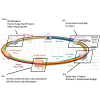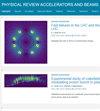圆柱壳碳化硅高阶模阻尼器的大功率测试结果
IF 1.8
3区 物理与天体物理
Q3 PHYSICS, NUCLEAR
Physical Review Accelerators and Beams
Pub Date : 2024-03-18
DOI:10.1103/physrevaccelbeams.27.031601
引用次数: 0
摘要
下一个大电流电子-离子对撞机(EIC)是布鲁克海文国家实验室与托马斯-杰斐逊国家加速器合作建造的新型加速器。在 EIC 电子存储环(ESR)中,束流将高达 2.5 A,这将在 17 个单细胞 591 MHz 超导射频(SRF)空腔中激发出巨大的高阶模(HOM)功率。在 ESR SRF 腔中阻尼 HOM 功率是一项挑战。由于碳化硅(SiC)光束线 HOM 吸收器(BLA)具有宽带和高功率能力,而且之前在其他加速器设施中进行过演示(尽管功率要低得多),因此被选为基准设计。由于 EIC BLA HOM 功率耗散远远大于之前的应用,因此在最终确定设计之前,必须进行大功率测试,以确定在热传输、射频击穿和机械应力方面可达到的最大器件性能水平。我们制作了具有最先进几何尺寸的 SiC HOM 吸波器原型,以验证收缩贴合技术、测试排气率和大功率处理能力。本文介绍了 HOM 减震器的原型设计和测试结果。本文章由计算机程序翻译,如有差异,请以英文原文为准。

High-power test results for a cylindrical-shell silicon carbide higher-order-mode damper
The next high-current Electron-Ion Collider (EIC) is a new accelerator to be built at Brookhaven National Laboratory in collaboration with Thomas Jefferson National Accelerator Facility. In the EIC Electron Storage Ring (ESR), there will be beam currents of up to 2.5 A, which will excite massive higher-order-mode (HOM) power in the 17 single-cell 591 MHz superconducting radio-frequency (SRF) cavities. Damping the HOM power in the ESR SRF cavities is a challenge. A room temperature cylindrical shell shape silicon carbide (SiC) beamline HOM absorber (BLA) was chosen as the baseline design, due to its broadband and high-power capability, and previous demonstrations at other accelerator facilities, albeit at much lower power. Because the EIC BLA HOM power dissipation is significantly greater than the previous applications, it is imperative to carry out high-power testing to determine the maximum device performance levels achievable for thermal transport, rf breakdown, and mechanical stress, prior to finalizing the design. A SiC HOM absorber with a state-of-the-art geometry size was prototyped to verify the shrink-fit technique, test outgassing rate, and high-power handling capability. This paper presents the HOM damper’s prototyping and test results.
求助全文
通过发布文献求助,成功后即可免费获取论文全文。
去求助
来源期刊

Physical Review Accelerators and Beams
Physics and Astronomy-Surfaces and Interfaces
CiteScore
3.90
自引率
23.50%
发文量
158
审稿时长
23 weeks
期刊介绍:
Physical Review Special Topics - Accelerators and Beams (PRST-AB) is a peer-reviewed, purely electronic journal, distributed without charge to readers and funded by sponsors from national and international laboratories and other partners. The articles are published by the American Physical Society under the terms of the Creative Commons Attribution 3.0 License.
It covers the full range of accelerator science and technology; subsystem and component technologies; beam dynamics; accelerator applications; and design, operation, and improvement of accelerators used in science and industry. This includes accelerators for high-energy and nuclear physics, synchrotron-radiation production, spallation neutron sources, medical therapy, and intense-beam applications.
 求助内容:
求助内容: 应助结果提醒方式:
应助结果提醒方式:


